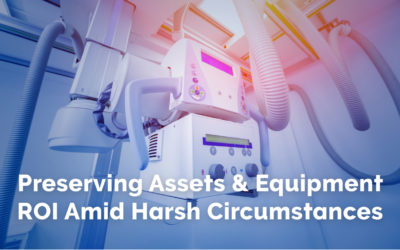Increasing efficiency and reducing unplanned downtime can be done by employing the correct maintenance management software program. This means industrial manufacturers must shift away from reactive maintenance and towards predictive maintenance (PdM) management.
The high cost of reactive maintenance
A reactive maintenance approach to parts and asset management has been one predominant strategy employed for many years in industrial manufacturing. This strategy relies heavily on allowing assets to break down or to run to failure before repairs are carried out. While a reactive maintenance approach is beneficial in the offset as it offers maximum utilization of assets, thereby maximizing production output, reactive maintenance is precipitated by failure in the long run.
While a reactive maintenance approach is beneficial in the offset as it offers maximum utilization of assets, thereby maximizing production output, reactive maintenance is precipitated by failure in the long run.
A reactive approach is detrimental as maintenance only occurs when the asset has already failed. Maintenance work is carried out in reaction to a breakdown.
Not being able to anticipate failures and remaining in a state of reactive maintenance can be a large financial burden on a manufacturer. A reactive maintenance strategy can result in:
- Reduced safety
- High unplanned downtime
- Maintenance labor inefficiency
- Shortened asset life
- Increased maintenance costs
Not being able to anticipate when maintenance tasks must occur means reactive maintenance tasks are more complex. And unfortunately, many manufacturers today still use a reactive maintenance strategy to keep their equipment and assets serviced.
Understanding predictive maintenance
Predictive maintenance, on the other hand, measures various critical parameters to monitor asset usage and performance to prevent asset breakdown and increase its lifespan.
Using a strategy of regularly scheduled maintenance allows teams to make smarter maintenance decisions, correcting any potential issues before failure can occur.
This type of computerized maintenance management system (CMMS) has increased in popularity in recent years thanks to Industry 4.0 and advancements in technology such as the Internet of Things (IoT) and advanced analytics.
With Industrial IoT and advanced analytics, manufacturers can realize greater equipment utilization, lower operational costs, and improvements in worker productivity.
The connected technologies used in this CMMS maintenance management system enables maintenance teams to gain real-time insights on critical performance indicators like asset health. Data gained through predictive analytics also contributes to predicting future outcomes.
This ensures that maintenance resources are deployed more effectively and efficiently.
Getting started with predictive maintenance
Making the transition from reactive maintenance to a predictive-based approach is not without its challenges. Establishing a new maintenance strategy is complex and requires time to set up. Implementing the right CMMS maintenance management is necessary to ensure success.
Creating the foundation for predictive maintenance requires a detailed plan of action.
Infrastructure, equipment, technology, and user adoption protocols are areas of the business that must be developed to fully integrate a PdM strategy.
If you’ve been considering starting a predictive maintenance program, read on. Below, we highlight key steps to implementing smart predictive maintenance that improves efficiency, quality, and optimal asset maintenance.
Step 1: Start with a pilot
Facilitating a PdM program is a significant undertaking. A long-term, best-in-class predictive maintenance strategy won’t be built in a day. As such, the initial effort should be focused on identifying key assets and establishing the presence of actionable data.
Sensor implementation and data streaming connections should be leveraged to integrate the PdM program into the company’s legacy CMMS or other maintenance management systems.
The goal of the pilot is to determine if predictive maintenance has value to the organization. Assessing predictive maintenance on one or two PdM-ready assets will ensure the correct program and technology suite is in place before the strategy is adopted company-wide.
Step 2: Build a predictive maintenance team
The individual members of your PdM team will be responsible for user adoption protocols. As such, the team should consist of internal stakeholders outside of the maintenance department.
Key members of the PdM team should include departmental heads such as production and customer service managers and staff members who interact with equipment and assets daily. Having a broad membership will ensure that the PdM program can leverage staff expertise and that the goals of predictive maintenance are understood by every department.
Step 3: Select the right predictive maintenance solution
To realize the full capabilities of a PdM program and aggregate the correct performance data, the right resources and technology must be in place. Depending on what assets are being monitored, this may include anything from sensors and infrared cameras to data collectors.
Successful adoption of a PdM program requires the right partner. Work with a vendor that has the right features and PdM options your assets and facility needs. Every industrial manufacturer is different. This means that the right PdM vendor for your organization is one that has the equipment and services that best fit your assets.
Step 4: Begin asset monitoring and data collection
The success of any predictive maintenance program is predicated on the data it gathers. Data will inform patterns in real-time, allowing the maintenance team to effectively and efficiently employ the program’s predictive capabilities.
Analysis software provided by your chosen vendor will be necessary to monitor the data streams in real time. A data scientist can collect performance data as well as other asset failure data to create predictive models and machine learning algorithms that assess optimized failure thresholds.
Identifying when failure thresholds will occur will help your organization to deploy the right resources when an asset reaches its failure threshold. This will increase production output and avoid unplanned downtime.
Step 5: Deploy and monitor
With the right technology and tools in place, the final step of implementation is deployment. While asset health monitoring takes time, fortunately, IoT and advancements in artificial intelligence data can be collected at incredible speeds.
Review the findings from the analysis software on a regular, ongoing basis to ensure successful implementation. Once a strategic predictive workflow is in place, introduce other assets to the PdM program.
Continue to retrain predictive models as new assets are introduced to synthesize learning as the program begins to scale.
Managing risk with predictive maintenance
As machines become more advanced and complex, and as rapid automation transforms the industry, performance metrics must be highlighted and maintained. A reactive or time-based maintenance management approach is not effective at reducing unplanned downtime.
Establishing a predictive maintenance program makes it possible for organizations to not only avoid unforeseen downtime, but also minimize operation disruption by identifying equipment failure before it occurs.
Through predictive maintenance, manufacturers can boost equipment reliability, run the facility efficiently and safely, and meet and exceed the company’s bottom line.
Interested in starting a predictive maintenance program and optimizing your facility’s maintenance today? Contact us today to get started on Aladdin, SGE’s cloud-based asset management system. Aladdin is packed with all the features your company needs to keep your facilities and equipment running smoothly for years to come.




0 Comments